Slip and Fall Incidents at Work: A Visual Analytics Analysis of the Research Domain
Abstract
1. Introduction
2. Data and Methods
2.1. Data Collection and Preliminary Analysis
2.2. Bibliometric Methods and Visualization Tools Used in the Analysis
3. Results
3.1. Authors Analysis
3.2. Institutions Analysis
3.3. Terms Analysis
3.4. Chronological Citation Network
4. Discussion
5. Conclusions
Author Contributions
Acknowledgments
Conflicts of Interest
References
- Kim, C.S.; Ro, S.Y.; Shin, D.S.; Kim, Y.J. Preventive effects of safety helmets on traumatic brain injury after work-related falls. Int. J. Environ. Res. Public Health 2016, 13, 1063. [Google Scholar] [CrossRef] [PubMed]
- Edwards, N.; Dulai, J.; Rahman, A. A scoping review of epidemiological, ergonomic, and longitudinal cohort studies examining the links between stair and bathroom falls and the built environment. Int. J. Environ. Res. Public Health 2019, 16, 1598. [Google Scholar] [CrossRef] [PubMed]
- Nasarwanji, M.F.; Sun, K. Burden associated with nonfatal slip and fall injuries in the surface stone, sand, and gravel mining industry. Saf. Sci. 2019, 120, 625–635. [Google Scholar] [CrossRef] [PubMed]
- Scott, K.A.; Fisher, G.G.; Barón, A.E.; Tompa, E.; Stallones, L.; DiGuiseppi, C. Same-level fall injuries in US workplaces by age group, gender, and industry. Am. J. Ind. Med. 2018, 61, 111–119. [Google Scholar] [CrossRef]
- Haslam, R.; Bentley, T. Follow-up investigations of slip, trip and fall accidents among postal delivery workers. Saf. Sci. 1999, 32, 33–47. [Google Scholar] [CrossRef]
- Jensen, O.C.; Sorensen, J.F.L.; Canals, M.L.; Hu, Y.; Nikolic, N.; Mozer, A.A. Non-fatal occupational injuries related to slips, trips and falls in seafaring. Am. J. Ind. Med. 2005, 47, 161–171. [Google Scholar] [CrossRef]
- Saadat, S.; Hafezinejad, N.; Ekhtiari, Y.S.; Rahimimovaghar, A.; Motevalian, A.; Aminesmaeili, M.; Sharifi, V.; Hajebi, A.; Radgoodarzi, R.; Hefazi, M. Incidence of fall-related injuries in Iran: A population-based nationwide study. Injury 2016, 47, 1404–1409. [Google Scholar] [CrossRef]
- Lee, S.; Lee, C.; Rodiek, S. Neighborhood factors and fall-related injuries among older adults seen by emergency medical service providers. Int. J. Environ. Res. Public Health 2017, 14, 163. [Google Scholar] [CrossRef]
- Kiyoshiteo, H.; Northrupsnyder, K.; Cohen, D.J.; Dieckmann, N.F.; Stoyles, S.; Wintersstone, K.M.; Eckstrom, E. Older hospital inpatients’ fall risk factors, perceptions, and daily activities to prevent falling. Geriatr. Nurs. 2019, 40, 290–295. [Google Scholar] [CrossRef]
- Leclerc, B.; Begin, C.; Cadieux, E.; Goulet, L.; Allaire, J.F.; Meloche, J.; Leduc, N.; Kergoat, M. Relationship between home hazards and falling among community-dwelling seniors using home-care services. Rev. Epidemiol. Sante Publique 2010, 58, 3–11. [Google Scholar] [CrossRef]
- Dahl, E. Passenger accidents and injuries reported during 3 years on a cruise ship. Int. Marit. Health 2010, 61, 1–8. [Google Scholar] [PubMed]
- MOL. Annual Labor Inspection Report; Ministry of Labor: Taipei, Taiwan, 2013. [Google Scholar]
- Masud, T.; Morris, R.O. Epidemiology of falls. Age Ageing 2001, 30, 3–7. [Google Scholar] [CrossRef] [PubMed]
- CARLSÖÖ, S. A method for studying walking on different surfaces. Ergonomics 1962, 5, 271–274. [Google Scholar] [CrossRef]
- Perkins, P. Measurement of slip between the shoe and ground during walking. Am. Soc. Test. Mater. Spec. Tech. Publ. 1978, 649, 71–87. [Google Scholar]
- Strandberg, L.; Lanshammar, H. The dynamics of slipping accidents. J. Occup. Accid. 1981, 3, 153–162. [Google Scholar] [CrossRef]
- Leclercq, S. The prevention of slipping accidents: A review and discussion of work related to the methodology of measuring slip resistance. Saf. Sci. 1999, 31, 95–125. [Google Scholar] [CrossRef]
- Kong, P.W.; Suyama, J.; Hostler, D. A review of risk factors of accidental slips, trips, and falls among firefighters. Saf. Sci. 2013, 60, 203–209. [Google Scholar] [CrossRef]
- Moon, Y.; Sosnoff, J.J. Safe landing strategies during a fall: Systematic review and meta-analysis. Arch. Phys. Med. Rehabil. 2016, 98, 783–794. [Google Scholar] [CrossRef]
- Hartung, B.; Lalonde, M. The use of non-slip socks to prevent falls among hospitalized older adults: A literature review. Geriatr. Nurs. 2017, 38, 412–416. [Google Scholar] [CrossRef]
- Wilkinson, A.; Meikle, N.; Law, P.; Yong, H.J.; Butler, P.H.; Kim, J.; Mulligan, H.; Hale, L. How older adults and their informal carers prevent falls: An integrative review of the literature. Int. J. Nurs. Stud. 2018, 82, 13–19. [Google Scholar] [CrossRef]
- Larsson, A.; Berggård, G.; Rosander, P.; Gard, G. Gait speed with anti-slip devices on icy pedestrian crossings relate to perceived fall-risk and balance. Int. J. Environ. Res. Public Health 2019, 16, 2451. [Google Scholar] [CrossRef] [PubMed]
- Grant, M.J.; Booth, A. A typology of reviews: An analysis of 14 review types and associated methodologies. Health Inf. Libr. J. 2009, 26, 91–108. [Google Scholar] [CrossRef] [PubMed]
- Pritchard, A. Statistical bibliography or bibliometrics. J. Doc. 1969, 25, 348–349. [Google Scholar]
- Cole, J.R.; Cole, S. The Ortega Hypothesis Citation analysis suggests that only a few scientists contribute to scientific progress. Science 1972, 178, 368–375. [Google Scholar] [CrossRef] [PubMed]
- Price, D.D.S. A general theory of bibliometric and other cumulative advantage processes. J. Am. Soc. Inf. Sci. 1976, 27, 292–306. [Google Scholar] [CrossRef]
- Valero, P.; Monk, A. Positioning HCI: Journals, descriptors and parent disciplines. Behav. Inf. Technol. 1998, 17, 3–9. [Google Scholar] [CrossRef]
- Zavod, M.; Hitt, J.M. Summary of the publishing trends of the Journal of Human Factors from 1988–1997. In Proceedings of the Human Factors and Ergonomics Society Annual Meeting; SAGE Publications: Thousand Oaks, CA, USA, 2000; pp. 108–111. [Google Scholar]
- Li, J.; Hale, A. Identification of, and knowledge communication among core safety science journals. Saf. Sci. 2015, 74, 70–78. [Google Scholar] [CrossRef]
- van Nunen, K.; Li, J.; Reniers, G.; Ponnet, K. Bibliometric analysis of safety culture research. Saf. Sci. 2018, 108, 248–258. [Google Scholar] [CrossRef]
- Jin, R.; Zou, P.X.W.; Piroozfar, P.; Wood, H.; Yang, Y.; Yan, L.; Han, Y. A science mapping approach based review of construction safety research. Saf. Sci. 2019, 113, 285–297. [Google Scholar] [CrossRef]
- Yang, Y.; Reniers, G.; Chen, G.; Goerlandt, F. A bibliometric review of laboratory safety in universities. Saf. Sci. 2019, 120, 14–24. [Google Scholar] [CrossRef]
- Merigó, J.M.; Miranda, J.; Modak, N.M.; Boustras, G.; de la Sotta, C. Forty years of Safety Science: A bibliometric overview. Saf. Sci. 2019, 115, 66–88. [Google Scholar] [CrossRef]
- Amin, M.T.; Khan, F.; Amyotte, P. A bibliometric review of process safety and risk analysis. Process Saf. Environ. Protect. 2019, 126, 366–381. [Google Scholar] [CrossRef]
- Li, J.; Reniers, G.; Cozzani, V.; Khan, F. A bibliometric analysis of peer-reviewed publications on domino effects in the process industry. J. Loss Prev. Process Ind. 2017, 49, 103–110. [Google Scholar] [CrossRef]
- Briganti, M.; Delnevo, D.C.; Brown, L.; Hastings, E.S.; Steinberg, B.M. Bibliometric analysis of electronic cigarette publications: 2003–2018. Int. J. Environ. Res. Public Health 2019, 16, 320. [Google Scholar] [CrossRef] [PubMed]
- Aparicio-Martinez, P.; Perea-Moreno, A.-J.; Martinez-Jimenez, P.M.; Redel-Macías, D.M.; Vaquero-Abellan, M.; Pagliari, C. A bibliometric analysis of the health field regarding social networks and young people. Int. J. Environ. Res. Public Health 2019, 16, 4024. [Google Scholar] [CrossRef] [PubMed]
- van Eck, N.J.; Waltman, L. Software survey: VOSviewer, a computer program for bibliometric mapping. Scientometrics 2010, 84, 523–538. [Google Scholar] [CrossRef]
- Small, H. Co-citation in the scientific literature: A new measure of the relationship between two documents. J. Am. Soc. Inf. Sci. 1973, 24, 265–269. [Google Scholar] [CrossRef]
- Kessler, M.M. Bibliographic coupling between scientific papers. Am. Doc. 1963, 14, 10–25. [Google Scholar] [CrossRef]
- de Beaver, D.B.; Rosen, R. Studies in scientific collaboration. Scientometrics 1979, 1, 133–149. [Google Scholar] [CrossRef]
- Van Eck, N.J.; Waltman, L.; Noyons, E.C.; Buter, R.K. Automatic term identification for bibliometric mapping. Scientometrics 2010, 82, 581–596. [Google Scholar] [CrossRef]
- Garfield, E.; Pudovkin, A.I. The HistCite system for mapping and bibliometric analysis of the output of searches using the ISI Web of Knowledge. In Proceedings of the 67th Annual Meeting of the American Society for Information Science and Technology; Information Today Inc.: Medford, NJ, USA, 2004. [Google Scholar]
- Bastian, M.; Heymann, S.; Jacomy, M. Gephi: An open source software for exploring and manipulating networks. In Proceedings of the Third International AAAI Conference on Weblogs and Social Media, San Jose, CA, USA, 17–20 May 2009. [Google Scholar]
- Garfield, E.; Paris, S.; Stock, W.G. HistCiteTM: A software tool for informetric analysis of citation linkage. Inf. Wiss. Prax. 2006, 57, 391. [Google Scholar]
- Garfield, E.; Pudovkin, A.I.; Istomin, V.S. Algorithmic citation-linked historiography—Mapping the literature of science. Proc. Am. Soc. Inf. Sci. Technol. 2002, 39, 14–24. [Google Scholar] [CrossRef]
- Leamon, T.B.; Murphy, P.L. Occupational slips and falls: More than a trivial problem. Ergonomics 1995, 38, 487–498. [Google Scholar] [CrossRef] [PubMed]
- Cham, R.; Redfern, M.S. Changes in gait when anticipating slippery floors. Gait Posture 2002, 15, 159–171. [Google Scholar] [CrossRef]
- Marigold, D.S.; Patla, A.E. Strategies for dynamic stability during locomotion on a slippery surface: Effects of prior experience and knowledge. J. Neurophysiol. 2002, 88, 339–353. [Google Scholar] [CrossRef]
- Cham, R.; Redfern, M.S. Heel contact dynamics during slip events on level and inclined surfaces. Saf. Sci. 2002, 40, 559–576. [Google Scholar] [CrossRef]
- Strandberg, L. On accident analysis and slip-resistance measurement. Ergonomics 1983, 26, 11–32. [Google Scholar] [CrossRef]
- Perkins, P.J.; Wilson, M.P. Slip resistance testing of shoes—New developments. Ergonomics 1983, 26, 73–82. [Google Scholar] [CrossRef]
- Strandberg, L. The effect of conditions underfoot on falling and overexertion accidents. Ergonomics 1985, 28, 131–147. [Google Scholar] [CrossRef]
- Tisserand, M. Progress in the prevention of falls caused by slipping. Ergonomics 1985, 28, 1027–1042. [Google Scholar] [CrossRef]
- Manning, D.P.; Ayers, I.; Jones, C.; Bruce, M.; Cohen, K. The incidence of underfoot accidents during 1985 in a working population of 10,000 Merseyside people. J. Occup. Accid. 1988, 10, 121–130. [Google Scholar] [CrossRef]
- Grönqvist, R.; Roine, J.; JÄRvinen, E.; Korhonen, E. An apparatus and a method for determining the slip resistance of shoes and floors by simulation of human foot motions. Ergonomics 1989, 32, 979–995. [Google Scholar] [CrossRef] [PubMed]
- Swensen, E.E.; Purswell, J.L.; Schlegel, R.E.; Stanevich, R.L. Coefficient of friction and subjective assessment of slippery work surfaces. Hum. Factors 1992, 34, 67–77. [Google Scholar] [CrossRef] [PubMed]
- Myung, R.; Smith, J.L.; Leamon, T.B. Subjective assessment of floor slipperiness. Int. J. Ind. Ergon. 1993, 11, 313–319. [Google Scholar] [CrossRef]
- Redfern, M.S.; Bidanda, B. Slip resistance of the shoe-floor interface under biomechanically-relevant conditions. Ergonomics 1994, 37, 511–524. [Google Scholar] [CrossRef]
- Grönqvist, R. Mechanisms of friction and assessment of slip resistance of new and used footwear soles on contaminated floors. Ergonomics 1995, 38, 224–241. [Google Scholar] [CrossRef]
- Bentley, T.A. Slip, trip and fall accidents occurring during the delivery of mail. Ergonomics 1998, 41, 1859–1872. [Google Scholar] [CrossRef]
- Hanson, J.P.; Redfern, M.S.; Mazumdar, M. Predicting slips and falls considering required and available friction. Ergonomics 1999, 42, 1619–1633. [Google Scholar] [CrossRef]
- Brady, R.A.; Pavol, M.J.; Owings, T.M.; Grabiner, M.D. Foot displacement but not velocity predicts the outcome of a slip induced in young subjects while walking. J. Biomech. 2000, 33, 803–808. [Google Scholar] [CrossRef]
- Chang, W.-R.; Grönqvist, R.; Leclercq, S.; Myung, R.; Makkonen, L.; Strandberg, L.; Brungraber, R.J.; Mattke, U.; Thorpe, S.C. The role of friction in the measurement of slipperiness, Part 1: Friction mechanisms and definition of test conditions. Ergonomics 2001, 44, 1217–1232. [Google Scholar] [CrossRef]
- Chang, W.-R.; Grönqvist, R.; Leclercq, S.; Brungraber, R.J.; Mattke, U.; Strandberg, L.; Thorpe, S.C.; Myung, R.; Makkonen, L.; Courtney, T.K. The role of friction in the measurement of slipperiness, Part 2: Survey of friction measurement devices. Ergonomics 2001, 44, 1233–1261. [Google Scholar] [CrossRef] [PubMed]
- Kemmlert, K.; Lundholm, L. Slips, trips and falls in different work groups—With reference to age and from a preventive perspective. Appl. Ergon. 2001, 32, 149–153. [Google Scholar] [CrossRef]
- Courtney, T.K.; Sorock, G.S.; Manning, D.P.; Collins, J.W.; Holbein-Jenny, M.A. Occupational slip, trip, and fall-related injuries can the contribution of slipperiness be isolated? Ergonomics 2001, 44, 1118–1137. [Google Scholar] [CrossRef] [PubMed]
- Redfern, M.S.; Cham, R.; Gielo-Perczak, K.; Grönqvist, R.; Hirvonen, M.; Lanshammar, H.; Marpet, M.; Pai, C.Y.-C.; Powers, C. Biomechanics of slips. Ergonomics 2001, 44, 1138–1166. [Google Scholar] [CrossRef] [PubMed]
- Grönqvist, R.; Abeysekera, J.; Gard, G.; Hsiang, S.M.; Leamon, T.B.; Newman, D.J.; Gielo-Perczak, K.; Lockhart, T.E.; Pai, C.Y.C. Human-centred approaches in slipperiness measurement. Ergonomics 2001, 44, 1167–1199. [Google Scholar] [CrossRef] [PubMed]
- Cham, R.; Redfern, M.S. Lower extremity corrective reactions to slip events. J. Biomech. 2001, 34, 1439–1445. [Google Scholar] [CrossRef]
- Chang, W.-R. The effects of slip criterion and time on friction measurements. Saf. Sci. 2002, 40, 593–611. [Google Scholar] [CrossRef]
- Lockhart, T.E.; Woldstad, J.C.; Smith, J.L. Effects of age-related gait changes on the biomechanics of slips and falls. Ergonomics 2003, 46, 1136–1160. [Google Scholar] [CrossRef]
- Chang, W.-R.; Li, K.W.; Huang, Y.-H.; Filiaggi, A.; Courtney, T.K. Assessing floor slipperiness in fast-food restaurants in Taiwan using objective and subjective measures. Appl. Ergon. 2004, 35, 401–408. [Google Scholar] [CrossRef]
- Li, K.W.; Chang, W.-R.; Leamon, T.B.; Chen, C.J. Floor slipperiness measurement: Friction coefficient, roughness of floors, and subjective perception under spillage conditions. Saf. Sci. 2004, 42, 547–565. [Google Scholar] [CrossRef]
- Bister, G. Closing of the Research Institute for Safety a Loss for OSH, American Society of Safety Engineeere. Available online: https://libertymutualresearch.org/american-society-of-safety-engineers/ (accessed on 1 May 2019).
- Newman, M.E. Fast algorithm for detecting community structure in networks. Phys. Rev. E 2004, 69, 066133. [Google Scholar] [CrossRef] [PubMed]

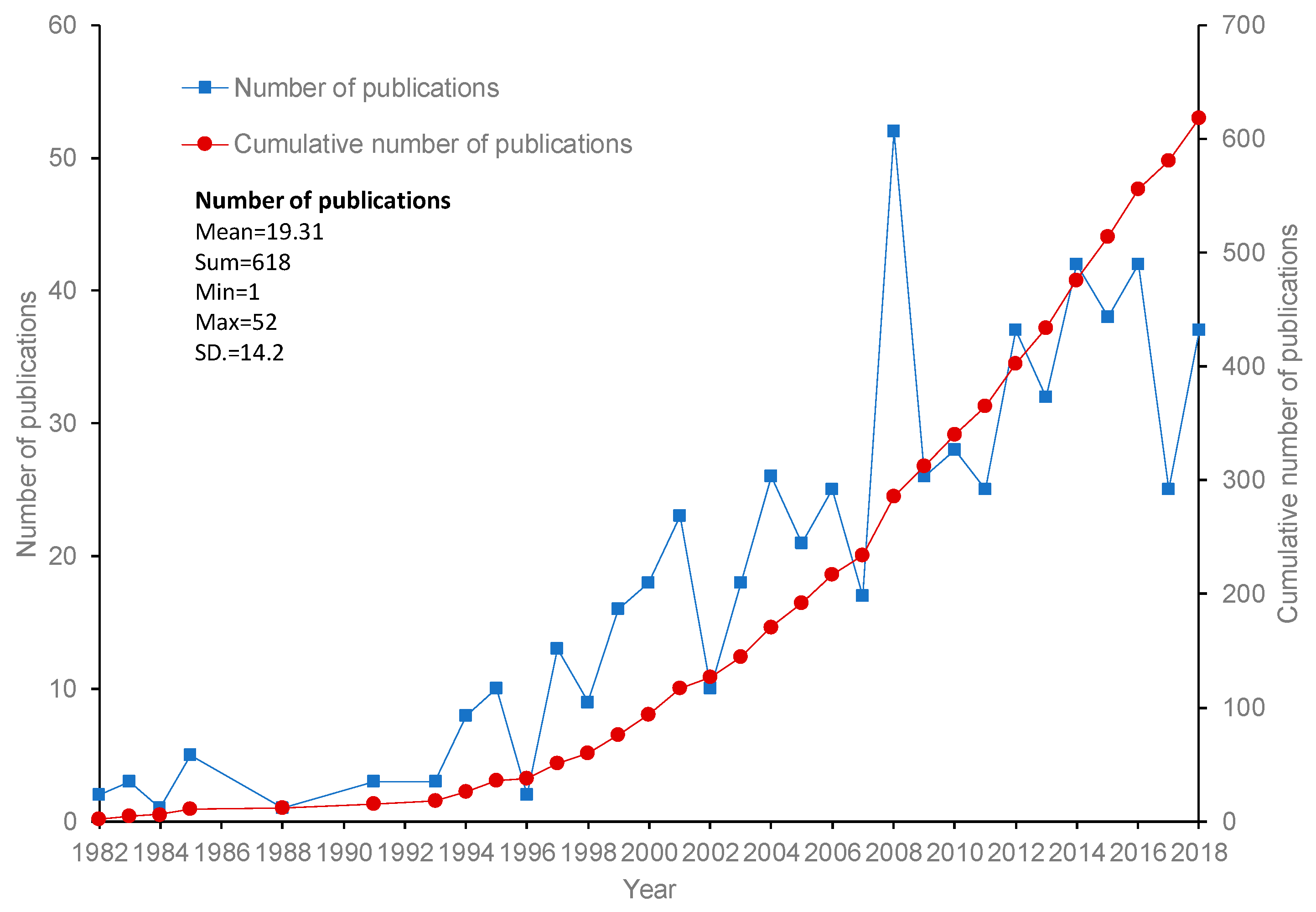
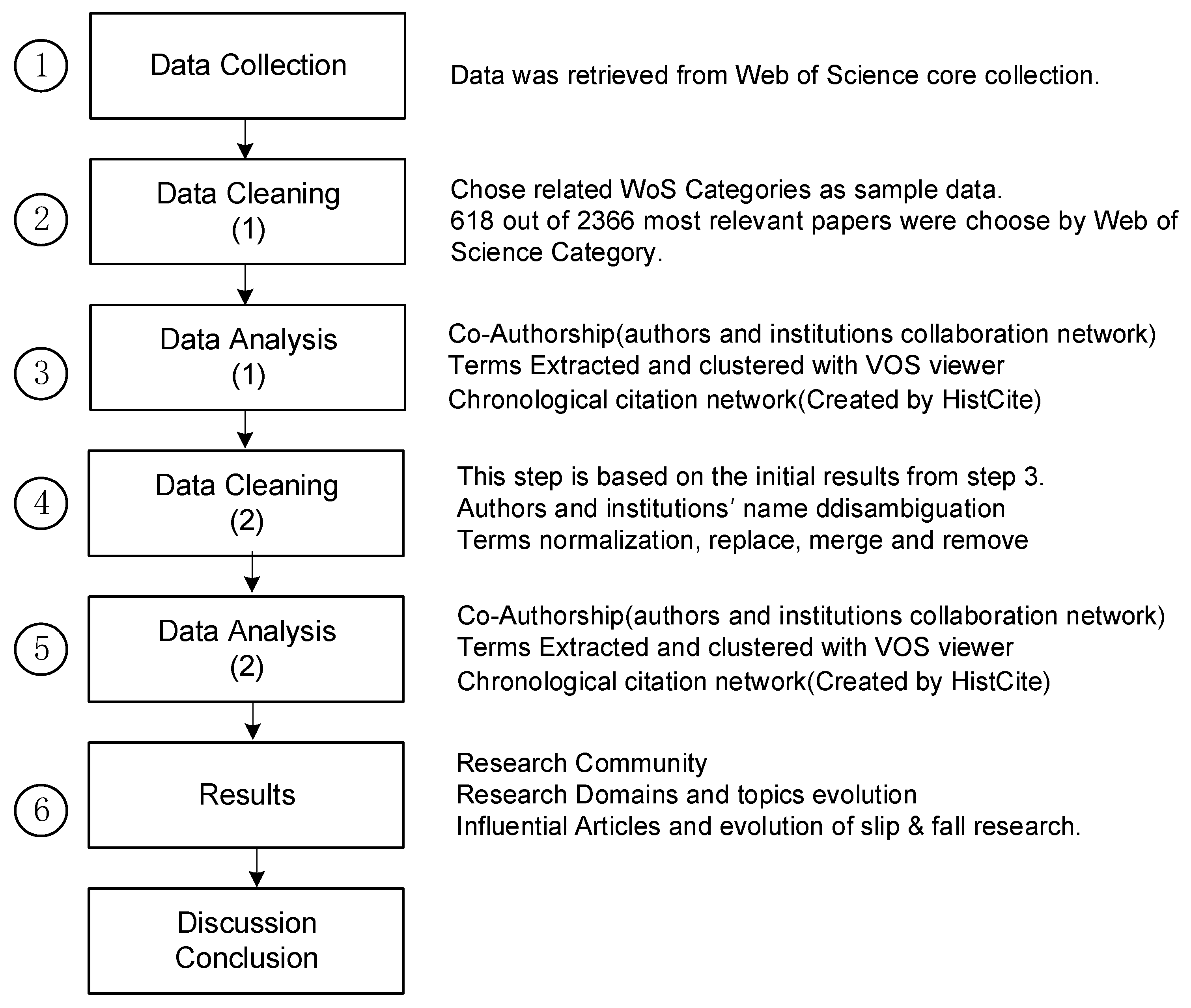
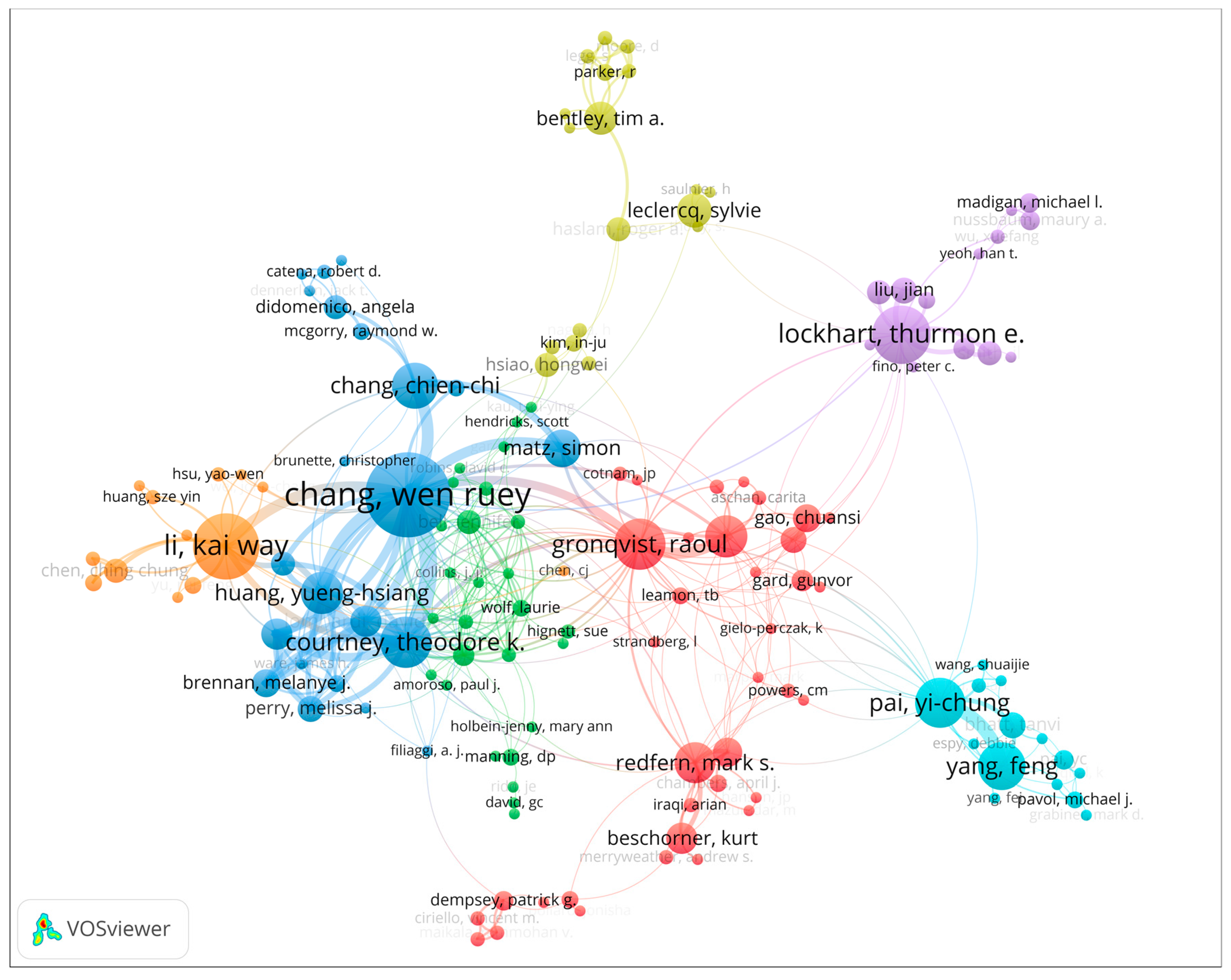
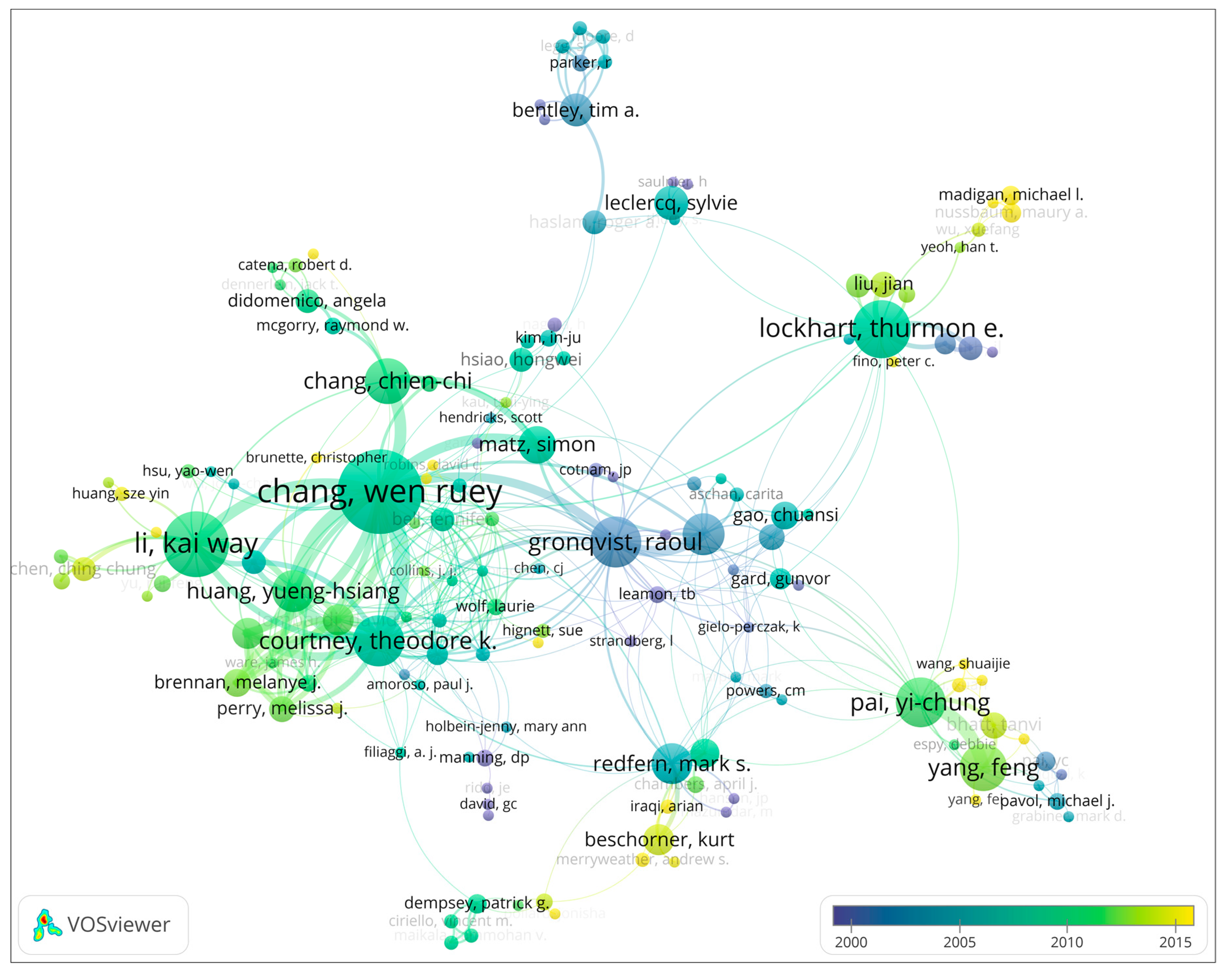
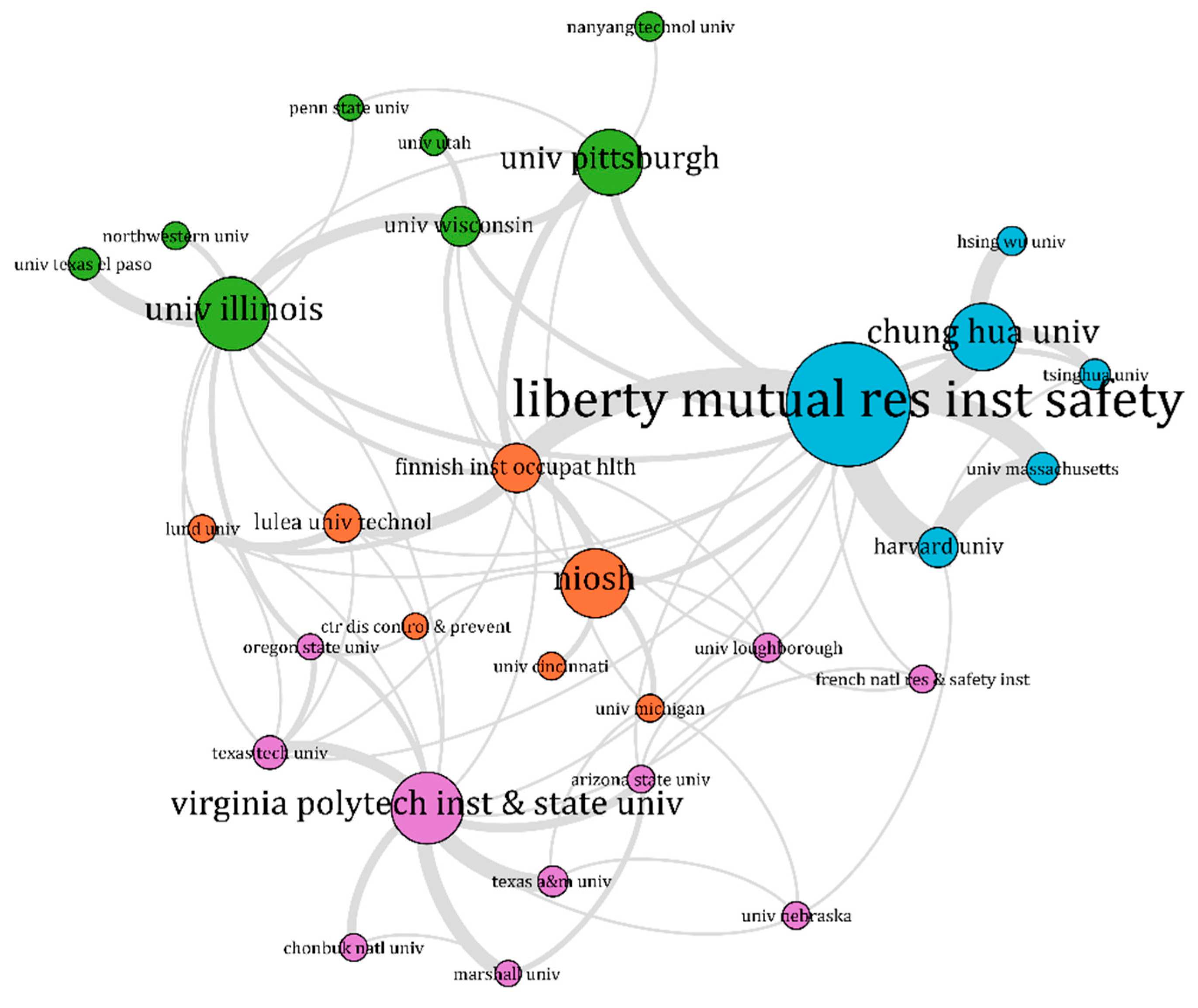
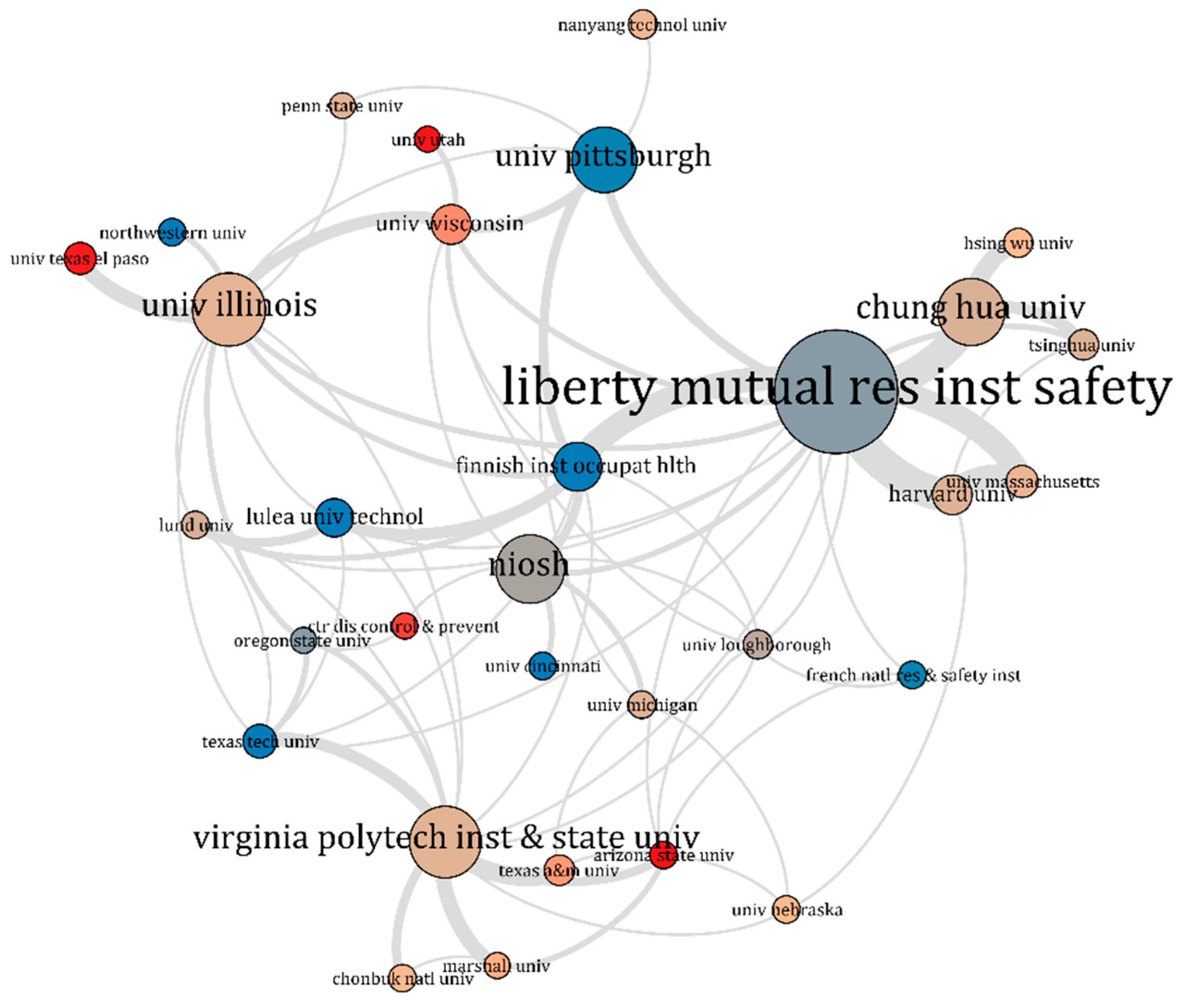
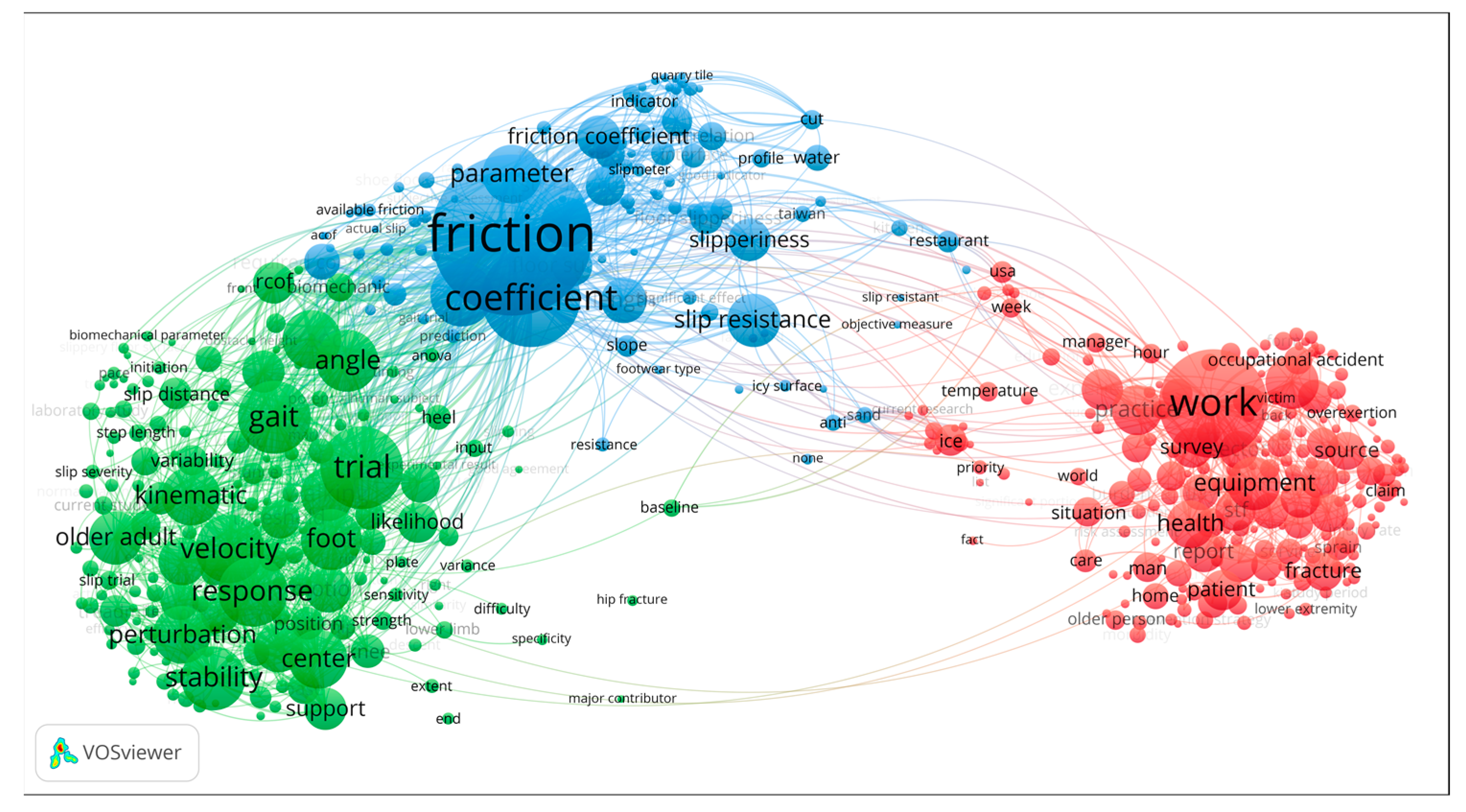

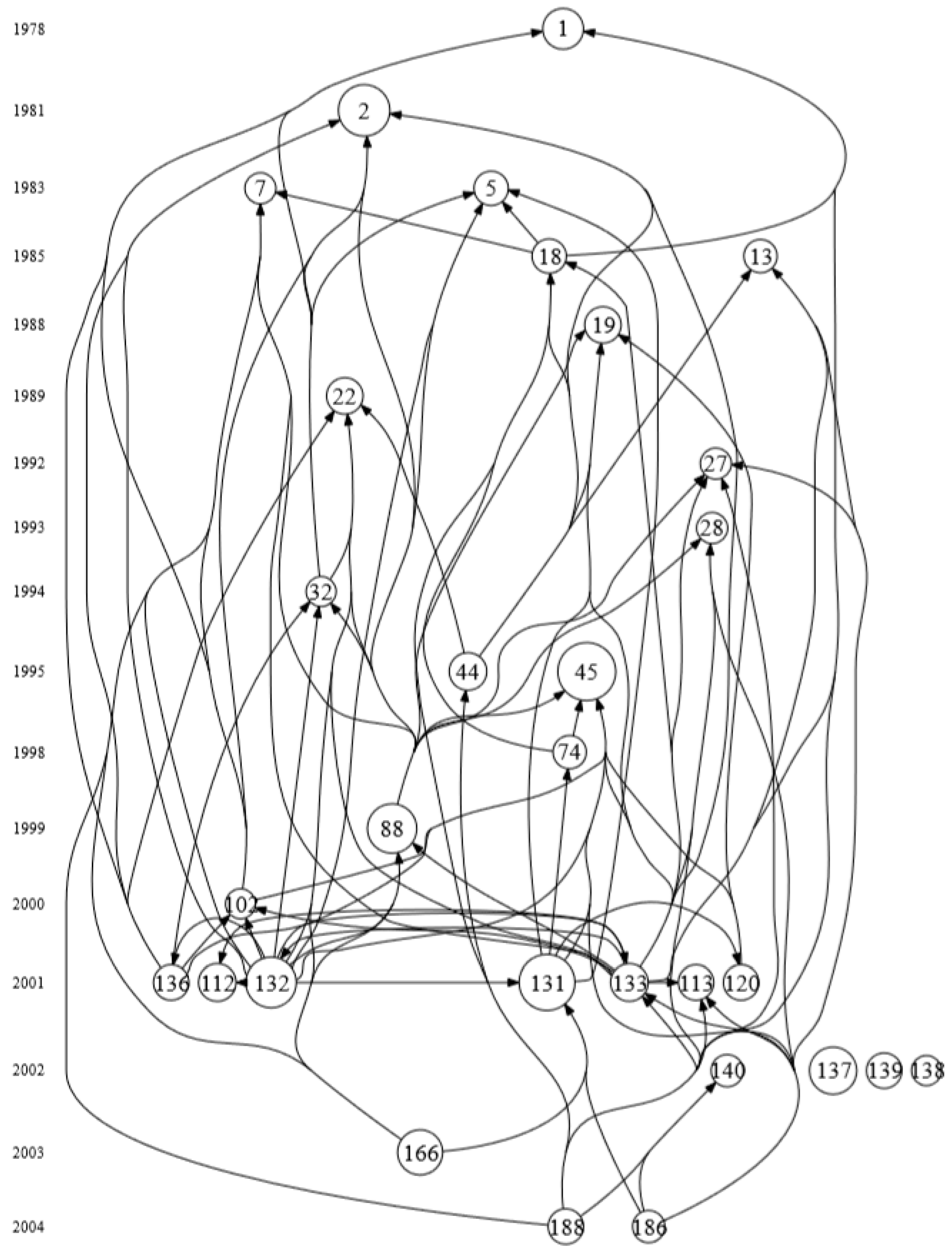
| Rank | Authors | Institutions | Links | TLS | NP | TC | APY |
|---|---|---|---|---|---|---|---|
| 1 | Chang, W.R. | LMRIS | 42 | 195 | 58 | 730 | 2008.62 |
| 2 | Li | Chung Hua Univ. | 21 | 76 | 38 | 403 | 2009.95 |
| 3 | Lockhart | Virginia Tech | 19 | 47 | 31 | 688 | 2008.77 |
| 4 | Courtney | LMRIS | 31 | 137 | 25 | 578 | 2007.96 |
| 5 | Gronqvist | Finnish Inst. Occupat. Hlth. | 34 | 86 | 25 | 695 | 2002.16 |
| 6 | Pai | Univ. Illinois | 20 | 49 | 24 | 602 | 2010.75 |
| 7 | Yang | Univ. Illinois | 8 | 30 | 22 | 328 | 2012.05 |
| 8 | Chang, C.-C. | LMRIS | 9 | 42 | 21 | 190 | 2010.05 |
| 9 | Hirvonen | Finnish Inst. Occupat. Hlth. | 15 | 42 | 18 | 436 | 2002.83 |
| 10 | Huang | LMRIS | 14 | 92 | 18 | 199 | 2010.50 |
| 11 | Redfern | Univ. Pittsburgh | 18 | 36 | 17 | 783 | 2005.12 |
| 12 | Matz | LMRIS | 8 | 35 | 15 | 186 | 2008.33 |
| 13 | Leclercq | French Natl. Res. & Safety Inst. | 6 | 8 | 13 | 151 | 2006.15 |
| 14 | Bentley | Massey Univ. | 8 | 23 | 12 | 308 | 2003.00 |
| 15 | Beschorner | Univ. Pittsburgh | 7 | 17 | 11 | 66 | 2013.73 |
| 16 | Lombardi | LMRIS | 17 | 76 | 11 | 139 | 2011.27 |
| 17 | Verma | LMRIS | 10 | 66 | 11 | 105 | 2011.27 |
| Rank | Institutions | Countries/Regions | Links | TLS | NP | TC | APY |
|---|---|---|---|---|---|---|---|
| 1 | Liberty Mutual Res. Inst. Safety | USA | 16 | 55 | 69 | 1397 | 2007.80 |
| 2 | Univ. Illinois | USA | 12 | 23 | 36 | 750 | 2011.36 |
| 3 | Virginia Polytech Inst. & State Univ. | USA | 13 | 30 | 35 | 671 | 2011.23 |
| 4 | NIOSH | USA | 7 | 12 | 33 | 709 | 2008.76 |
| 5 | Chung Hua Univ. | TAIWAN | 3 | 20 | 32 | 340 | 2010.69 |
| 6 | Univ. Pittsburgh | USA | 7 | 13 | 31 | 853 | 2005.94 |
| 7 | Finnish Inst. Occupat. Hlth. | FINLAND | 10 | 26 | 20 | 609 | 2004.25 |
| 8 | Harvard Univ. | USA | 4 | 21 | 14 | 181 | 2010.93 |
| 9 | Univ. Wisconsin | USA | 7 | 14 | 14 | 108 | 2014.57 |
| 10 | Lulea Univ. Technol. | Sweden | 6 | 11 | 13 | 253 | 2005.15 |
| Title of Each Cluster | Selected Terms in Each Cluster (Occurrences of a Term) | Legend | Size of The Cluster |
|---|---|---|---|
| 1# epidemiology and slip and fall incidence | Work (89), equipment (41), occupational injury (41), practice (38), health (36), experience (31), patient (30), report (30), STF(Slips, trips, and falls, 30), survey (30), effort (29), database (28), fracture (28), nature (28), review (28), sector (28), source (28), day (26), fatality (26). |  | 192 |
| 2# gait or biomechanical | Trial (66), gait (57), response (55), velocity (54), stability (50), angle (48), foot (47), center (45), kinematic (45), speed (45), perturbation (44), older adult (41), walking (41), mass (37), recovery (36), motion (34), ground reaction force (32), support (32), RCOF (required coefficient of friction, 31). |  | 165 |
| 3# friction measurement and coefficient | Friction (138), coefficient (81), experiment (49), parameter (45), slip resistance (41), COF (coefficient of friction, 38), length (34), friction coefficient (33), slipperiness (32), floor surface (30), surface condition (29), required coefficient (26), floor slipperiness (24), contaminant (22), friction measurement (21), correlation (20), water (19), interface (17), regression model (17). |  | 100 |
| RY | # | First Author | Year | Source | LCS | RLCS | References |
|---|---|---|---|---|---|---|---|
| 1 | 1 | Perkins | 1978 | Astm Stp | 53 | 8 | [15] |
| 2 | 2 | Strandberg | 1981 | J Occup Accid | 83 | 3 | [16] |
| 3 | 5 | Strandberg | 1983 | Ergonomics | 38 | 19 | [51] |
| 4 | 7 | Perkins | 1983 | Ergonomics | 31 | 27 | [52] |
| 5 | 13 | Strandberg | 1985 | Ergonomics | 36 | 21 | [53] |
| 6 | 18 | Tisserand | 1985 | Ergonomics | 37 | 20 | [54] |
| 7 | 19 | Manning | 1988 | J Occup Accid | 43 | 12 | [55] |
| 8 | 22 | Gronqvist | 1989 | Ergonomics | 43 | 13 | [56] |
| 9 | 27 | Swensen | 1992 | Hum Factors | 32 | 25 | [57] |
| 10 | 28 | Myung | 1993 | Int J Ind Ergonom | 32 | 26 | [58] |
| 11 | 32 | Redfern | 1994 | Ergonomics | 30 | 28 | [59] |
| 12 | 44 | Gronqvist | 1995 | Ergonomics | 45 | 9 | [60] |
| 13 | 45 | Leamon | 1995 | Ergonomics | 106 | 1 | [47] |
| 14 | 74 | Bentley | 1998 | Ergonomics | 35 | 22 | [61] |
| 15 | 88 | Hanson | 1999 | Ergonomics | 79 | 5 | [62] |
| 16 | 103 | Brady | 2000 | J Biomech | 30 | 29 | [63] |
| 17 | 112 | Chang W.R. | 2001 | Ergonomics | 44 | 10 | [64] |
| 18 | 113 | Chang W.R. | 2001 | Ergonomics | 39 | 15 | [65] |
| 19 | 120 | Kemmlert | 2001 | Appl Ergon | 39 | 16 | [66] |
| 20 | 131 | Courtney | 2001 | Ergonomics | 98 | 2 | [67] |
| 21 | 132 | Redfern | 2001 | Ergonomics | 81 | 4 | [68] |
| 22 | 133 | Gronqvist | 2001 | Ergonomics | 44 | 11 | [69] |
| 23 | 136 | Cham | 2001 | J Biomech | 39 | 17 | [70] |
| 24 | 137 | Cham | 2002 | Gait Posture | 70 | 6 | [48] |
| 25 | 138 | Marigold | 2002 | J Neurophysiol | 30 | 30 | [49] |
| 26 | 139 | Cham | 2002 | Safety Sci | 40 | 14 | [50] |
| 27 | 140 | Chang W.R. | 2002 | Safety Sci | 34 | 23 | [71] |
| 28 | 166 | Lockhart | 2003 | Ergonomics | 64 | 7 | [72] |
| 29 | 186 | Chang W.R. | 2004 | Appl Ergon | 33 | 24 | [73] |
| 30 | 188 | Li | 2004 | Safety Sci | 39 | 18 | [74] |
© 2019 by the authors. Licensee MDPI, Basel, Switzerland. This article is an open access article distributed under the terms and conditions of the Creative Commons Attribution (CC BY) license (http://creativecommons.org/licenses/by/4.0/).
Share and Cite
Li, J.; Goerlandt, F.; Li, K.W. Slip and Fall Incidents at Work: A Visual Analytics Analysis of the Research Domain. Int. J. Environ. Res. Public Health 2019, 16, 4972. https://doi.org/10.3390/ijerph16244972
Li J, Goerlandt F, Li KW. Slip and Fall Incidents at Work: A Visual Analytics Analysis of the Research Domain. International Journal of Environmental Research and Public Health. 2019; 16(24):4972. https://doi.org/10.3390/ijerph16244972
Chicago/Turabian StyleLi, Jie, Floris Goerlandt, and Kai Way Li. 2019. "Slip and Fall Incidents at Work: A Visual Analytics Analysis of the Research Domain" International Journal of Environmental Research and Public Health 16, no. 24: 4972. https://doi.org/10.3390/ijerph16244972
APA StyleLi, J., Goerlandt, F., & Li, K. W. (2019). Slip and Fall Incidents at Work: A Visual Analytics Analysis of the Research Domain. International Journal of Environmental Research and Public Health, 16(24), 4972. https://doi.org/10.3390/ijerph16244972







